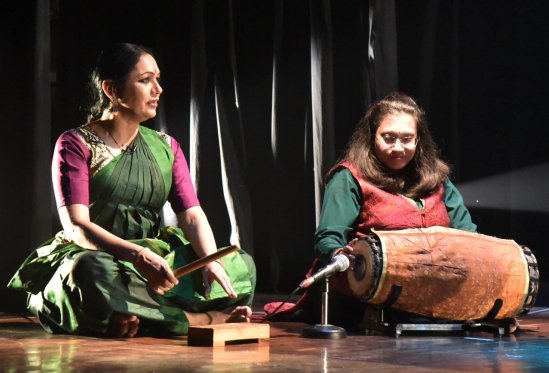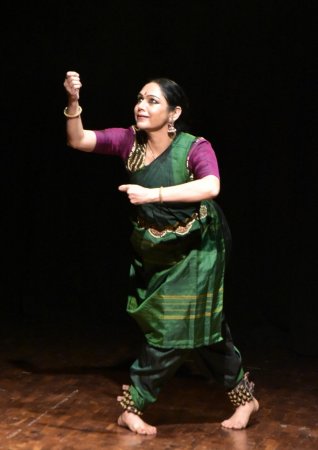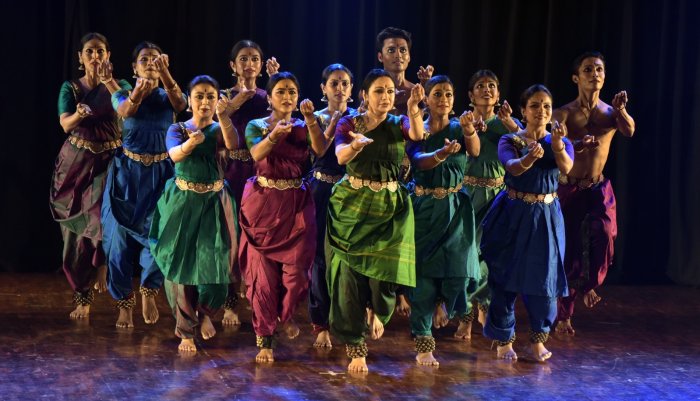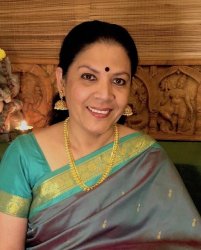
|   |

|   |
Storm before the calm - A yogic reflection - Ramaa Bharadvaj e-mail: ramaabharadvaj@gmail.com Photos: Srivatsa Shandilya December 29, 2024 A note to the readers ... In December 2024, I was invited to watch Rama Vaidyanathan's new work, "The Storm before the Calm" in Bengaluru. It was an intriguing concept that manifested in five acts via Rama's choreographic vision, and unravelled Tantric revelations in me. Given below are my reflections of this production, written from the perspective of both a dancer as well as a Yoga enthusiast. - Ramaa Bharadvaj If a 'Theme' were a human, feeling depressed about being labelled as "dry subject", then Rama Vaidyanathan has got to be the ultimate 'Vaidya' who can cure it of its ailment! Yes! Rama possesses this singular talent of making even the most abstract concept come alive with crystalline precision, and, more importantly, drenched in 'rasa'. Case in point, Rama's new work, "The Storm before the Calm" that I experienced on Friday, December 20, 2024 in Bengaluru (hosted by Diya Performing Arts). It took me back to 15 years ago, to the epiphanies I had while creating a small solo work before departing from the US. I had titled it "Dancing into Stillness", and I recall the insightful moments that would unfold even during its scripting. Rama whisked me off to many such meditative realms, and in an evocative way which was both temporal and eternal, both earthly and ethereal. Act 1: According to Tantra Shastra, all finite objects have the capacity to create a portal for the soul to see, feel and know the Infinite. In dance, the body becomes that finite tool, the primary sacred space with its two-way potentiality - first for accessing the inner "Calm", and then for its outer expression through the "Storm". Therefore, the external layer (where the first sprout of movement germinates) is to be penetrated first, during the training phase.  Rama Vaidyanathan & Sannidhi Vaidyanathan And this is where Rama's "Storm before the Calm" begins. Accompanied by her daughter Sannidhi Vaidyanathan's clean mridangam rhythms, the dancers begin to literally excavate patterns of movements from within the "finite-body-tool", as if in preparation for it to embody Divinity. Act 2: Saint Thirumoolar's verse "anandam adarangam" follows, escorting this concept further through layers of space discovery - from somatic space to external space. Rama uses 'adavu' movements that have a deconstructed simplicity to them. But her superbly trained ensemble of eleven dancers traverse the stage space with them - each distinctly, yet cohesively - as if gesturally proclaiming the Upanishadic statement of "paths may be different, but destination is the same". With every contour and cross-line displaying its own purpose and mission, it turns into an unpredictable adventure, and the "bliss" that the saint talks about as emanating from Lord Nataraja's dance becomes vivid. Act 3: Next, it is Muthuswami Dikshitar's masterpiece "Tyagaraja yoga vaibhavam". There could not have been a more worthy choice to structurally mirror Rama's concept of moving from the storm towards the calm, because, after all, this composition itself begins in 'gopuccha yati' (rhythmic meter resembling the tail of a cow), where the opening words are rendered in a tapering fashion, reducing from nine syllables to one. However, instead of following the reducing pattern as given by Dikshitar, Rama chooses to start with the reduced word "vam" and expand it to fullness. This created a moment of Tantric significance for me, because 'vam' is after all the seed syllable (bija mantra) of the psychic energy centre (chakra) of "creativity". What better invocatory sound can there be to depict the creative flame of an artist? And the way Rama responds to the rendition of the bija, evoked yet another meaning for me. She shoots up from the stage floor with an extended finger pointing to the heavens, as if reaching towards the Eternal Source, for a spark of that creativity. It instantly brought to my mind Michelangelo's famous 'Creation of Adam' representing the divine breath of life with God's and Adam's fingers almost touching each other. From that profound opening, bloom layers of depictions of Lord Tyagaraja's form as the primal cause of creation, and the bestower of both worldly enjoyment and liberation. My favourite was the myriad ways in which the serpent adores the Lord in the phrase "nagaraja vinuta padam." The piece ends as powerfully as it began - with Rama becoming the dance synergist whose hypnotic depiction of expansion and contraction of breath sucks in the Eternal Almighty towards her, for the ultimate union.  Rama Vaidyanathan Act 4: The word "dance" evokes many definitions - movement, action, rhythm, stories. However, these "Storms" are only lateral experiences - like the rim of a wheel. The axle of the Dance Wheel is stillness. Therefore, attention is to be given to the fortification of the internal mind as well. This premise is delineated through metaphorical depictions in the next Thirumanthiram verse "adangatha ennai adakki". The first imagery is that of a fluttering kite. Rama simply walks in, with one hand raised, palm and wrist undulating with flaps, waves and swoops, and the concept of the uncontrolled mind becomes explicit. "The painter's brush flies all over the canvas, yet the painting is contained within the frame. So also, contain my wandering self and abide in me," pleads the poet. Rama depicts this not with hand gestures and expressions, as dancers commonly do. She emotes with her entire body moving in a distinctively unfettered style. Rooted in one place, her torso, neck and arms sway with total abandonment as she herself becomes the "brush". And when the "painting" is done, the stillness that emanates creates a picture of serenity. Act 5: The exploration continues, transcending into the Universal space, where the microcosm becomes the mirror reflecting the macrocosm. Thirumoolar's verse "bhoothanda, peythanda, bhoganda" describing the various Universes, provides the canvas and Rama's ensemble bursts into action. Pritam Das, with one spectacular gyrational gesture of his torso takes us into the aquatic depths where life is said to have commenced on earth. And soon, the entire stage gets animated as fawns leap, birds flutter, bees buzz, branches sway, sheets of rain perform their descending dance, vegetation springs to life, and flashes of lightning illuminate this entire spectacle. I ask myself, "Is this what Nandikeswara visualised when he described Siva's dance as the movement of the Universe in his verse 'aangikam bhuvanam yasya'?" And it is on that link with the Universe that the production culminates.  Ensemble The on-stage success of a concept of this nature depends on how effectively the dancers are able to bring it to life. Rama's ensemble deserves to be applauded wholeheartedly. Each dancer, individually, is a solo-worthy artist with excellent technique and laudable creative talents. (For example, Prachi Save Sathi's "When Walls Dance" is one of the most imaginative works I have seen in recent times). Together, as a group, they did more than reproduce the choreography; they awakened the very spirit of the concept through their involved, vivacious interpretation of each moment, and each movement. Special kudos to Sudha Raghuraman for her impactful tuning of the songs and her soulful rendition of them. Her impeccable Tamil pronunciation, and ability to infuse each phrase with bhava was an asset. Surya Rao's sensitive lighting design punctuated each scene and idea with drama without overpowering it. The one suggestion I have for Rama is to re-record the intros that preceded each act. These succinctly poetic statements were crucial for audience to understand the framework of each scene. However, the sound quality made them difficult to follow. I conclude with an anecdote that Rama once shared with me about her school days. "Whereas my classmates would come back after their summer holidays with exciting adventures in Ooty and Kodaikanal, all I did was visit ashrams in Rishikesh and Siddhabari. That's where my mother would take me," she once said, and we had a good laugh about it. But, it is probably those experiences that are implanted in Rama's psyche, enabling her to effortlessly dream up such concepts of spiritual significance. I thank your beautiful mother for this, Rama, and may the "seeker" in you continue to create more such "calms" through your "storms".  Ramaa Bharadvaj is a celebrated dancer, choreographer, storyteller, humorist, educator, and writer. During the 31 years that she lived and worked in the US, Ramaa received multiple Lester Horton Awards for her choreographies, and served as arts advisor for state and national arts agencies. Ramaa returned to India in 2009, and currently lives in Bengaluru. She conducts workshops, writes and speaks on the Arts for diverse groups, and creates stories for the world. |